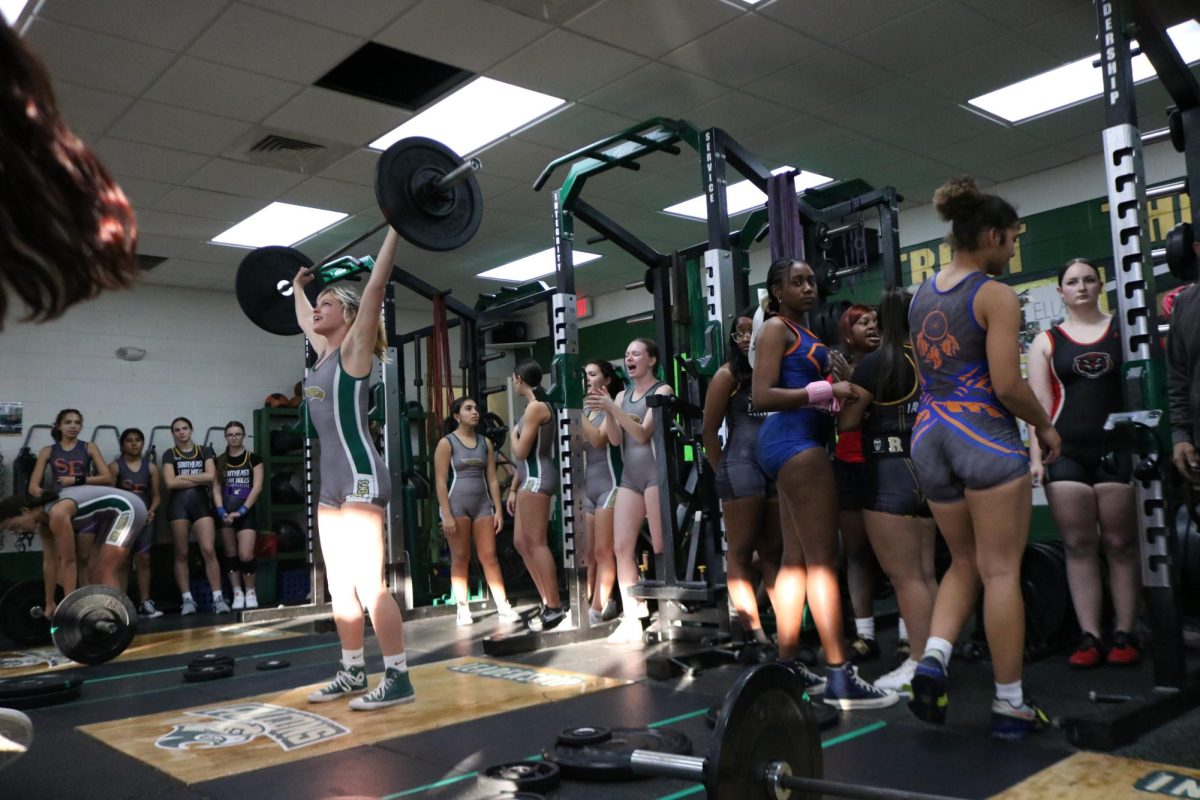The toxicity of modern gym culture
As social media increases the competitive aspect of weightlifting, how can lifters stay safe in the gym? Gauntlet Editor-in-Chief Sully Maley gives his take on modern gym culture.
Many inexperienced lifters put themselves at risk of injury by incorrectly performing exercises such as the deadlift.
May 4, 2021
As an avid gym-goer, I often encourage many of my friends to work out more frequently. A healthy exercise routine consisting of a good balance between cardio and strength training can deliver a host of benefits, including increased strength, immunity, and cardiovascular health.
But as is par for the course in the modern world, social media has turned a healthy habit into a reckless clout chase. Trends and influencers on apps such as TikTok and Instagram have inspired many young people to start lifting, but to do so with unhealthy methods and unrealistic goals. These include an unnecessary focus on one’s maxes and utilizing risky lifting techniques to move dangerous amounts of weight, often with the help of addicting caffeine-based stimulants.
The so-called “big three” of bodybuilding are likely the first lifts that come to mind when considering a trip to the gym: barbell squat, bench press, and deadlift. But these exercises are rather ineffective considering their high-risk nature and the rather low level of muscular development they promote. These movements become even more dangerous when inexperienced young lifters hopped up on pre-workout supplements and TikTok bodybuilding videos attempt to “max out” with unhealthy levels of weight.
Barbell squats (a back squat in which weight is placed on one’s shoulders) are extremely dangerous due to the load they place on one of the most fragile components of the human body: the knee. When a lifter raises a barbell from a full-depth (butt to the floor) squat, their knees do the majority of the work, placing the fragile ligaments of a crucial joint under extreme pressure. Barbell squats also entail placing weight directly on one’s neck, a process that can lead to severe spinal injury.
In addition, while many squatters claim that this exercise promotes quadricep growth, barbell squats primarily help to develop your gluteal muscles (a group of three muscles that make up the buttocks). Lifters looking to develop leg muscle can turn to more safe and effective machine alternatives such as seated curls and extensions. Another effective leg day workout is the incline press, which can allow a lifter to push upwards of 400 pounds with lower risk of knee or neck injury.
The bench press has been a popular social lift since the 1950s and is often arbitrarily used as the gold standard for comparing strength between lifters. When done correctly, benching can be a relatively safe exercise, but pushing too much weight can lead to severe shoulder injury. According to the University of Rochester Medical Center, bench press most commonly leads to injuries such as rotator cuff tears and osteoarthritis of the shoulder. Safer alternatives to bench pressing include fly machines, which work minor chest muscles left out by the bench press, and dumbbell press, which allows lifters to more safely manage their press weight while efficiently developing their pectoral muscles.
Last but not least is the deadlift. Possibly the most ineffective lift in the book, deadlifts create an extremely high risk for injury while delivering almost no rewards in terms of muscle growth. While it is preached as an effective “full-body exercise,” studies have shown that vastly more effective workouts exist for developing both back and leg muscles. What deadlift is effective at is causing injuries for inexperienced lifters. Just the slightest error in form can lead to severe back injuries such as slipped disks or back sprains. Even with good technique, deadlifting often leaves experienced lifters sore for days after, sacrificing the effectiveness of subsequent workouts to perform a lift that does virtually nothing for long-term muscle development.
The dangers of these lifts are all exacerbated by the toxicity of modern gym culture. As bodybuilders on social media continue to promote “maxing out” as the sole mark of success in the gym, many lifters put themselves at risk for such injuries by attempting to lift weights they are not prepared for. This leads to an increased risk of a severe injury which would ultimately set back any lifter’s progress far more than taking a plate or two off the bar.
In order to chase unrealistic maxes, many lifters turn to supplements known as “pre-workout” before hitting the gym. These highly caffeinated products, which often contain a cocktail of other stimulants, are said to help lifters increase their focus and confidence in the gym, leading to better performance.
Consuming high levels of stimulants directly before working out can often lead to injury, as it enables lifters to attempt to overload their lift without clear awareness of their limits. One 2016 study showed that caffeine can lower the sensitivity of adenosine receptors used during nociception, the process through which one’s brain processes pain. The pain reception process is an important part of a safe lift, as it allows one to realize when they may be attempting to push too much weight. By inhibiting this process, lifters put themselves at higher risk of overuse injury.
Expecting to lift more weight on every single trip to the gym is a rather unhealthy goal. Frequent lifters, especially those who are already in good physical shape, cannot realistically push more weight each and every day.
Instead, manage your workouts through rep ranges. A healthy rep range is about 8-12. If you can’t reach eight reps in a set, bring the weight down. Once you’re able to do 12 good reps with a weight, adding a bit more that you can do for at least 8 will challenge your muscles, and gradually working up in this rep window is a safe and effective way to achieve gains.
The same goes for assessing your progress in the gym. Rather than measuring your success through how much you can bench for a single rep, think about how you look and feel, as these are likely the things you set out to change when you began your fitness journey. Just as many nutritionists preach about body weight, numbers aren’t everything. Don’t work out to impress others on social media. Work out for you and your exercise needs. Your body, health, and confidence will thank you. http://webbanki.ru



























































Ashton K CPT • Jan 25, 2023 at 7:54 am
Where are your citations? You are making brazen accusations about lifts and their “ineffectiveness” on the body and muscles. You use the phrase “studies show” yet the study you cited third paragraph in the introduction states “Deadlift is primarily performed when the goal is STRENGTHENING of thigh, and posterior chain muscles such as the gluteus, hamstrings, erector spinae, and quadriceps. Thus, deadlift is classified as one of the most typical RESISTENCE exercise for posterior lower limb strengthening.” The definition of resistance training is any exercise that causes the muscles to contract against an external resistance with the expectation of increases in strength, power, HYPERTROPHY (muscle cell growth) and endurance.” I bolded hypertrophy and put the meaning in the definition to emphasize that’s what a deadlift can contribute to. Lastly, you basically said that everyone who takes preworkout or a stimulant before a workout is an idiot and can’t control themselves to be smart and only lift weights that they can. So now anyone who takes a stimulant is going to have to expect to hurt themselves in the gym because they’re so pumped up and can’t control adding another 45 to the squat bar even though they can’t handle it. Lets do better next time.